In addition to his pivotal role at LA Country Club and the SCGA, Ed Tufts was also the head of the Pacific Coast Golf Association and later the California Golf Association, and that was in addition to his civic commitments. Renaissance man!
Category: Hotel Del Monte Country Club
The Virginia Country Club’s 100th Anniversary at Los Cerritos!

At Rancho Los Cerritos in Long Beach, on September 1, 1921, a day after the new Hunt & Burns clubhouse was dedicated, the new William Watson designed grass-green golf course of the Virginia Country Club opened to its members.
The club had voted to move from Los Alamitos after ten years, leaving their old Arthur Rigby designed links to become Recreation Park municipal golf course.
The Virginia Country Club of Long Beach incorporated in 1909, and like many California golf clubs, was started by land and hotel owners working together to bring people to their cities and resorts. It was Hotel Virginia manager and avid golfer Carl Stanley who led the committee to find a location for a country club and golf links. The committee chose Los Alamitos due to its large lake and forest of Blue Gum trees, plus its location on the electric train line to Huntington Beach.

After Long Beach, Stanley become the long time manager of the Hotel Del Monte, where he stayed in charge from 1915-1941, fathering the Pebble Beach golf links and other Del Monte Properties golf courses.
©2021 jib jones – golfhistoricalsociety
The Opening of Los Angeles Country Club’s W. Herbert Fowler designed North course in 1921
It was with great anticipation that Los Angeles Country Club’s new North course at Beverly officially opened to members on Wednesday, August 10, 1921, making LA CC the first club in California to have adjoining eighteen hole golf courses. The new course had been “thrown open for practice,” in early June, and members had declared it couldn’t be improved.
The big event of the opening day was an exhibition match between green committee man, George C. Thomas Jr., who laid out the W. Herbert Fowler designed eighteen hole golf course, paired with Miss Doreen Kavanagh, Southern California and State amateur champion, playing against Southern California amateur champion and general manager of Catalina Island Company, Everett Seaver, and Northern California women’s champion, Miss Margaret Cameron.
Thomas and Kavanagh defeated Cameron and Seaver by a score of 3 up and 3 to play. Broken down, Thomas beat Seaver, 1 up, and Kavanagh beat Cameron 3 and 2, in what was called a keen match.
After the exhibition there was a dinner and dancing for 400. The day’s events were filmed.
The club’s Superintendent of Grounds for many years was Charles Cavanaugh. He and his crew did an amazing job building and rebuilding holes for both new golf courses in under a year, all while keeping 18 holes open for competition.
Alex J. Morrison, of Los Angeles Municipal, Catalina Island, and vaudeville, who had started at LACC as a caddy at Pico and Western, was appointed professional in July of 1921, replacing golf legend John Duncan Dunn and his team of British golfers. Morrison’s assistants were Vic Dalberto and Harry McNamara. Alex was soon back on stage and replaced at LACC by Alex Duncan, brother of earlier LACC professional James Duncan, and British golf legend George Duncan.
There was so much praise heaped on George C. Thomas Jr., for laying out the North course, that Herbert Fowler got more than a bit lost in the press releases. Fowler was a very busy man that summer, having completed the South and North courses for LA CC, the Ambassador-Rancho Golf Club, redesigns of Del Monte #1 and #2 (Pebble Beach), and designs for the Presidio, Olympic Club, Burlingame, Crystal Springs and others.
The North course still has 12-13 original holes laid out by Fowler that were reconstructed by William P. Bell to George C. Thomas Jr.’s redesign in 1928, when they also added five new holes. The 2010 Gil Hanse restoration was to the 1928 Fowler-Thomas-Bell version of the North, plus rebuilding the old Fowler par three 17th (replaced in 1928), which is now an extra hole.
On August 10, 2021, we can celebrate the design brilliance of Herbert Fowler, George C. Thomas Jr., and William P. Bell, along with the restoration by Gil Hanse. Happy 100th Birthday LA CC North!
©2021 J.I.B. Jones -golfhistoricalsociety.org
A Matter of Course – The Life of William Herbert Fowler 1856-1941
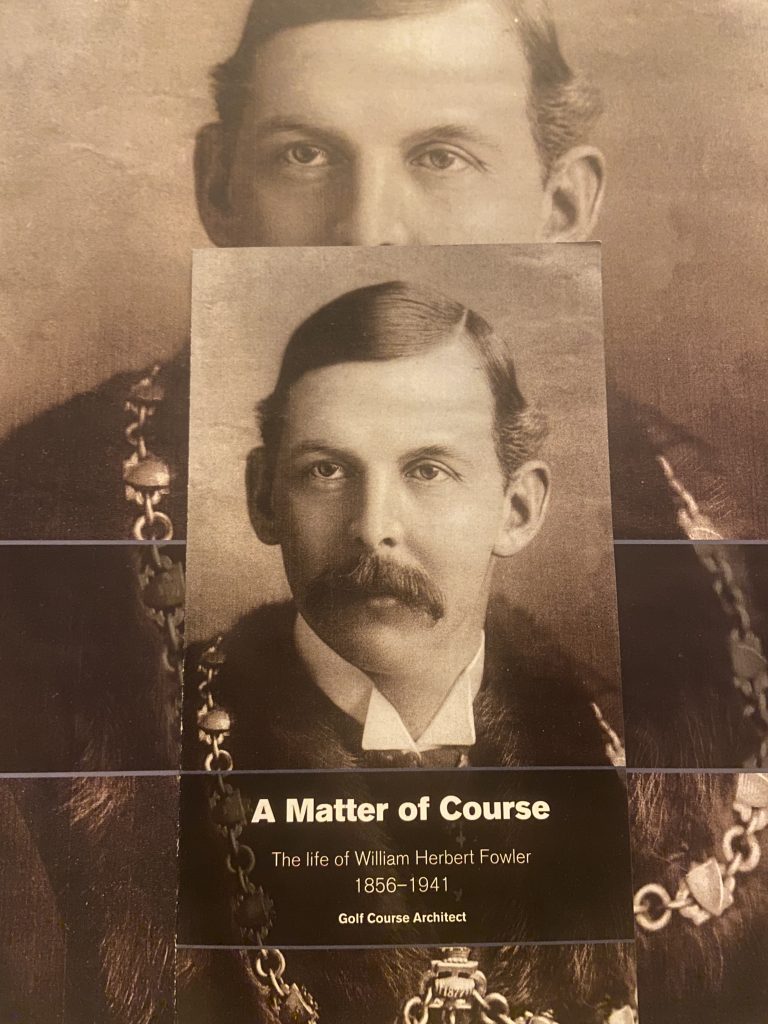
A Matter of Course is a new book written by Derek Markham and published by Markham & Truett.
The story of legendary golf course architect William Herbert Fowler. The book is a proper biography of a most interesting life, mostly well lived.
I contributed research to the chapter, “American Adventures,” written about Fowler’s work in California, which included Los Angeles Country Club, Pebble Beach and the Del Monte Hotel courses, the Presidio, Burlingame Country Club, the no longer existing Ambassador/Rancho Golf Club, Olympic Club, Lincoln Park, Sequoyah, Del Paso, Crystal Springs, Menlo C.C., and others!
This is a small print of 650 books that can be ordered by emailing Philip Truett:
philip@truett.co.uk
or ordering online from Browns Books
Pebble Beach Opened with Irrigation in March 1918 says Neville.
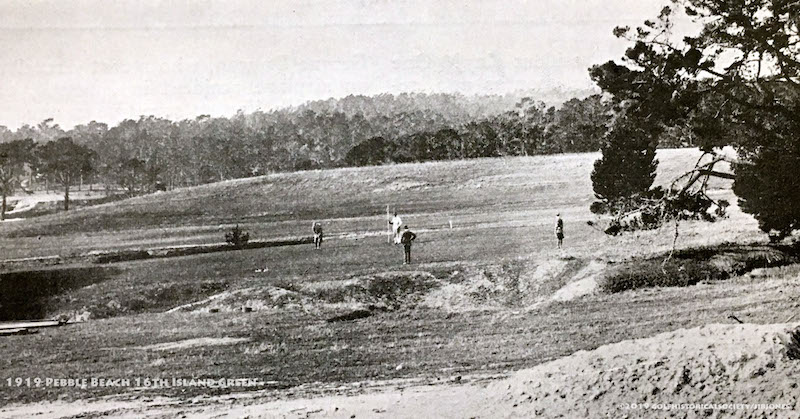
“The new course, which has just been opened for play at Pebble Beach, to be known as the Del Monte Second Championship Course, has as complete a watering system as was ever devised. It is already in working order, and with like comparison the other features of the course are having their development in the most scientific and intelligent manner.”
“The watering system on this course is capable of distributing two million gallons per week, which, with the annual rainfall, aggregates seventy inches a year on the watered area. These facts illustrate that California is prepared to take care of all the golfers in the country and give them excellent courses under ideal conditions.” – from The Golfer’s Happy Hunting Grounds by Jack Neville. Pacific Golf and Motor, March, 1918.
©2019 golfhistoricalsociety/jib jones
Del Monte No. 2 at Pebble Beach Version 1
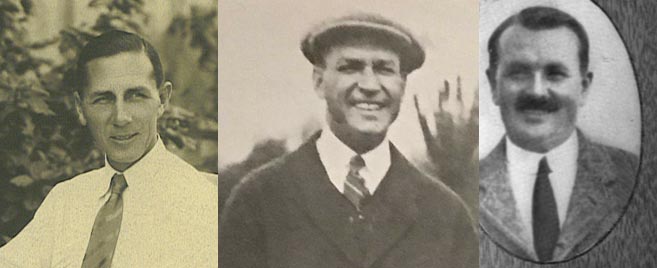
In January 1916, the Hotel Del Monte announced they were planning to build a much needed second golf course at Moss Beach, as professional golfers Walter Fovargue, Wilfrid Reid and James Donaldson arrived to remodel the Del Monte No. 1 golf course for the Western Golf Association’s Western Amateur and Open championships, to be held in July.
With California Golf Association secretary, Del Monte Country Club green chairman, and Del Monte Golf manager, Jack Neville, out of town at the Western Golf Association meeting in Chicago (where he offered a free train ride to entrants), the trio made a plan for laying out a new course at Pebble Beach, as an alternative to Moss Beach. All three were designing the new Lakeside course in San Francisco, and Fovargue would shortly design new courses for the Santa Barbara Country Club, the Annandale Golf Club, and Victoria Club in Riverside.
By early February, the Hotel Del Monte announced they were switching the location of their second course from Moss Beach to Pebble Beach, where the Forest Lodge would be transformed into a golf club house. Two weeks later, Wilfrid Reid joined Jimmy Donaldson, who was already on the ground, and together they began construction of the Pebble Beach golf links.
More than a year later, in March 1917, the Hotel Del Monte announced the new Del Monte No. 2 golf course at Pebble Beach was designed by Jack Neville and Douglas Grant of the Del Monte Country Club green committee, who had chosen the best solutions from six different plans to create the new layout, which would cost $100,000, and would open by September 1917.
The first score card that I have found is from March 1, 1917. The back nine should add up to 36, with the course a Par 73. Here is a clip of it from the San Francisco Chronicle:
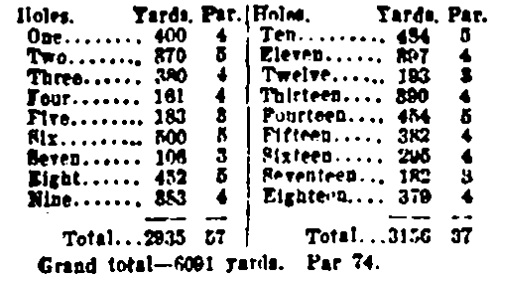
In an amazing coincidence, or spurred on by Neville’s offer of a free train ride from Chicago for entrants in the Western Amateur, the United States Golf Association revised their rules in April 1916, regarding the “Magna Charta” of the Amateur Golfer, specifically stating that golfers could not accept travel or living expenses for playing in a tournament, contest, or exhibition, and would be deemed professional, if they make money “writing, editing or publishing articles, magazines or books on golf, or to laying out, constructing, supervising or giving advice concerning the layout, construction or upkeep of a golf course or any part thereof.” The W.G.A. followed suit in April 1917, also making golf course architects professionals.
Giving credit for the new course to Neville and Grant as amateur architects, even after the U.S.G.A. changed its rules and started the fight that would end the W.G.A., was unfortunate for the other early contributors: James Donaldson, Wilfrid Reid, Walter Fovargue, George Smith, Del Monte manager Carl S. Stanley, and California golf legends Roger Lapham and Ed Tufts of the California Golf Association, who all played a big hand in the creation of golf at Pebble Beach.
More Pebble Beach golf links articles from Golf Historical Society
©2019 jibjones all rights reserved
101 Years of Golf at Pebble Beach 1918-2019
By J.I.B. Jones
DEL MONTE No. 2. golf course at Pebble Beach
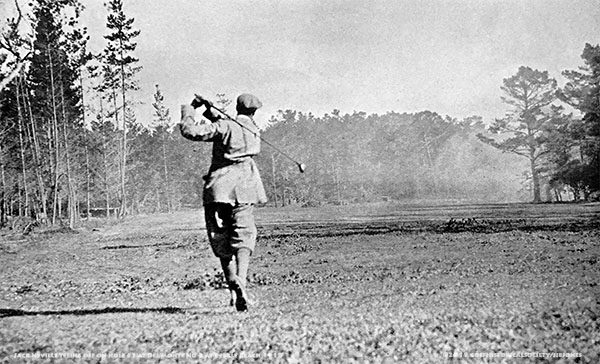
“Undoubtedly the golfer on his first visit to Pebble Beach has a delightful surprise in store, for he will find an all-grass links, tees, fairways, and greens.“ (R.H. Hay Chapman, April, 1918)
The story of the Hotel Del Monte No. 2 golf course at Pebble Beach has been smudged into propaganda, which is not likely to change, especially in 2019, with the onslaught of publicity for Pebble Beach’s “100th anniversary,” and the holding of the U.S.G.A.’s Open Golf Championship in celebration thereof.
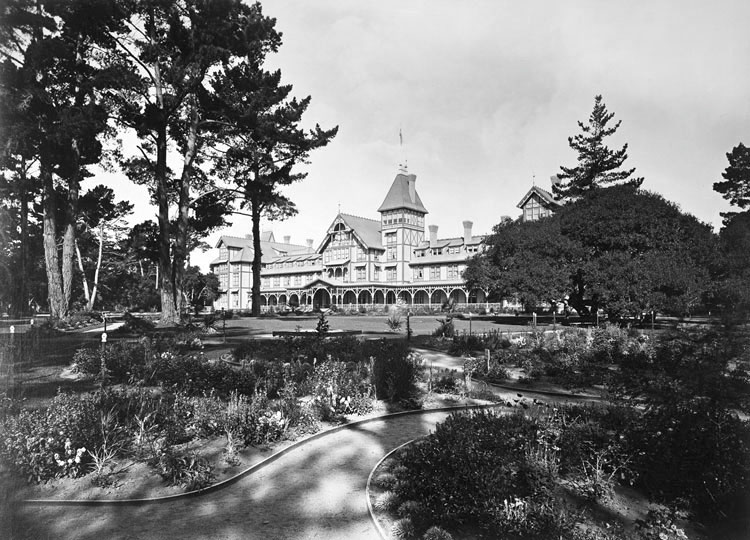
The truth is, the Hotel Del Monte was the grandest resort in California history, and the center of California golf competition since the Del Monte Cup in 1899. The Pacific Coast Golf Association was founded at Del Monte in 1901, and the California Golf Association in 1911, by which time the all-grass Del Monte No. 1 golf course had become overly congested with golfers.
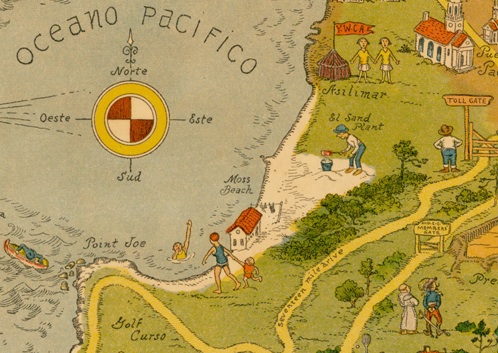
After taking advice from numerous golf experts, who were unanimous in their opinion, plans were announced on December 26, 1915, by Hotel Del Monte manager Carl Stanley for building a Scottish golf links on the sand dunes at Moss Beach early in the New Year. New manager Stanley was an ardent golfer known for developing the Hotel Virginia and the Virginia Country Club at Long Beach. His son Ashton Stanley was California’s first Junior golf champion in 1919.
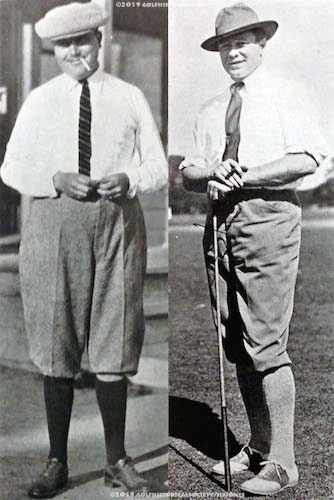
As fate would have it, over New Years 1915-16, Del Monte property company manager, and ardent polo player, Sam Morse arrived to look over development plans for his Del Monte Unit. Strangely, Morse soon sent a telegram to the Universal Film Company at Universal City, Los Angeles, offering 20,000 acres of the Monterey peninsula to Hollywood as a movie set. This, thankfully, never happened!
After consulting with Carl Stanley and Del Monte golf manager Jack Neville, Morse shelved plans to spend $250,000 on the golf links at Moss Beach and decided that Pebble Beach was a much better and far more affordable location, as it already had a club house, the Hotel’s electric bus service, and Jack Neville’s real estate office, which needed a lot of help!
Aside from being the manager of Del Monte’s golf division and the Pebble Beach subdivision, Jack Neville was also the secretary of the California Golf Association, and publisher of their organ, Pacific Golf & Motor magazine, as well as a legendary multiple championship winning amateur golfer, and coincidently, chairman of the Del Monte Golf and Country Club green committee along with amateur champion Douglas Grant and club president, and California golf legend, Charles Maud.
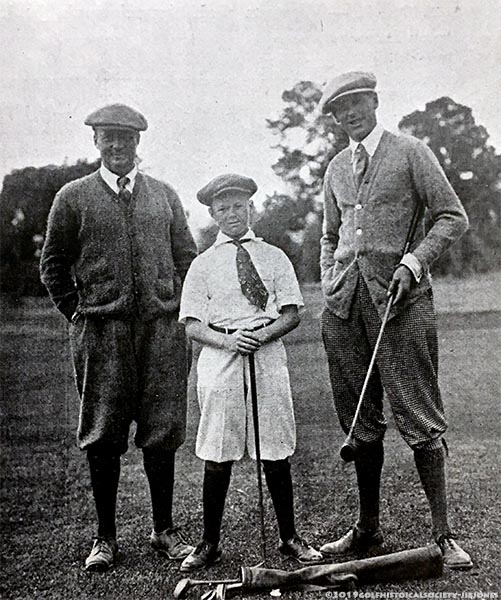
In January 1916, Stanley and Neville hired professional golfers James Donaldson (Scotland), Wilfrid Reid (England), and Walter Fovargue (U.S.A.), to remodel the Del Monte No. 1 golf course for the Western Amateur Championship in July. In February, Donaldson and Reid began laying out holes at Pebble Beach, and by March 1917, Neville and Grant had chosen the final layout from six different plans, and the new Del Monte No. 2 golf course at Pebble Beach was born.
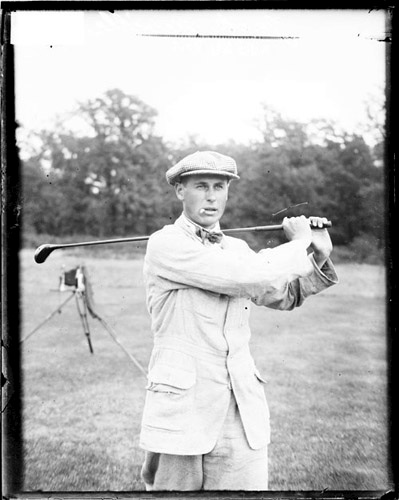
Jack Neville was indeed the true “architect” of the Pebble Beach golf course, as he planned and superintended every detail of its construction, and by February 1918, the all-grass course had the best tees and fairways in the State of California. It had cost the company $100,000, with $22,000 spent on underground piping for the 450 outlet irrigation system, which in 1918 was “the most up to date and efficient water system in the United States.“ (W.A. Buckner, Golfers Magazine 1921)
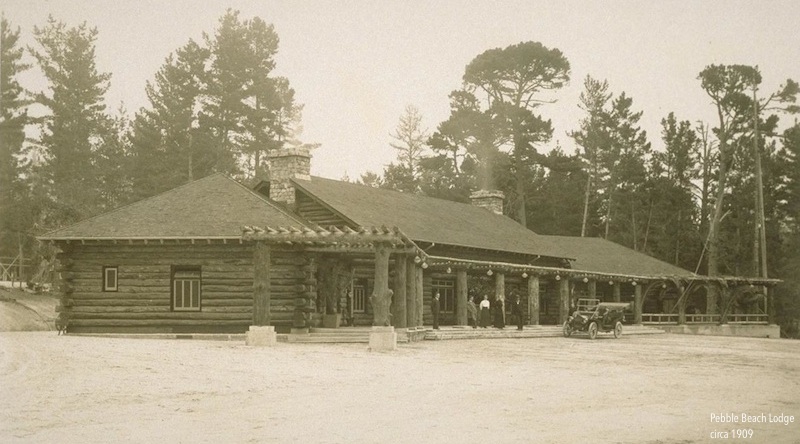
Unfortunately, on December 16, 1917, just eight weeks before the opening, fire destroyed the Pebble Beach Forest Lodge club house, which was a huge blow to the company. As soon as possible a new golf shop and lockers were constructed, and plans were drawn by Lewis Hobart (who also designed the old Lodge) for a new and much larger lodge, which wouldn’t open until 1919.
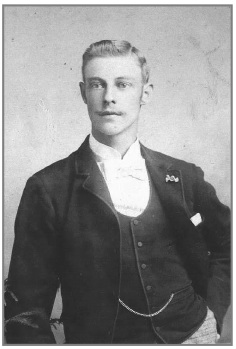
With the Pebble Beach golf course opening delayed until March 1918, Stanley and Neville had a chance to do more work on the greens, which had grown poorly over the wet winter. They hired America’s turf and grass expert, William Tucker, who rebuilt and re-seeded the troubled greens, but it was too late for them to be fully ready for opening day.
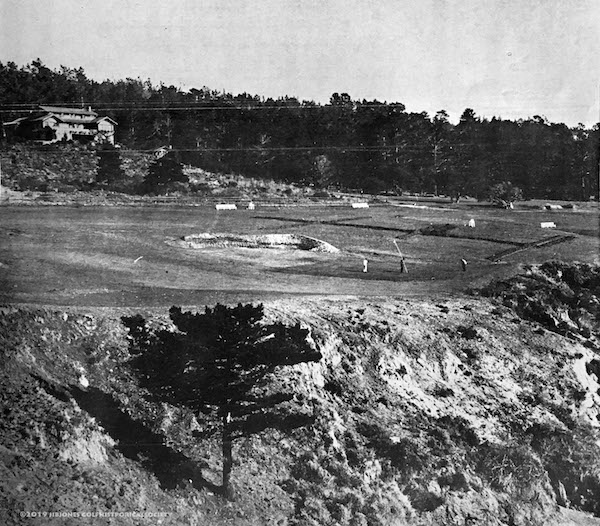
Del Monte No. 2 at Pebble Beach (Pebble Beach Golf Links) opened for play on March, 30, 1918. The new golf course was 6,588 yards, par 74, from the championship tees, and 6,188 yards from the alternate tees. It is interesting to note that the original eighteenth hole was a 575 yard, par 5, which must have been altered by the construction of the new lodge, which was built on the south side of 17-mile drive (Cypress), across the road from the old lodge.
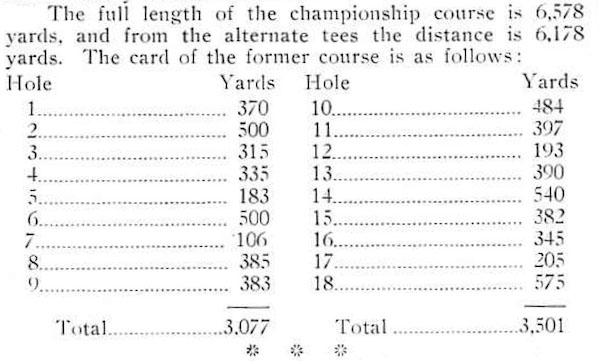
“Natural Hazards abound and the ocean hazards, while not difficult, will be real mental hazards for all the challengers of ‘Mr Par’. Whether the second rater or dub golfer will be able to get around the course in respectable figures without the loss of half a dozen balls is something that can only be answered when conditions are more normal.” (“Bobs” – San Francisco Chronicle, March 31, 1918)
The first golf tournament was a Four Ball “foursomes” match with teams of amateurs against professionals and was played on the following day (March 31).
In the feature match of the Four Ball, Jack Neville teamed with Fred Reilly and beat professionals Mike Brady & Tom McQuarrie, 4 and 3.
Neville and Reilly also had the low best ball score of 71.
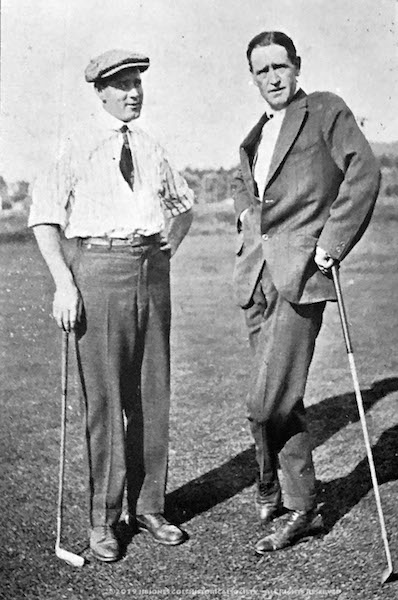
On April 1st, 1918, the Hotel Del Monte held an Open tournament over thirty-six holes, medal play, for amateurs and professionals. Many amateurs chose not to lose any more golf balls and joined the gallery. Bets were laid that no player would beat 160 for two rounds from the championship tees. Instead they saw the hottest golfer in America, Mike Brady of Boston and Brentwood Country Club, Los Angeles, play like a machine and score 79-75, for 154, winning over runner-up and Pebble Beach professional Harold Sampson by thirteen strokes! Low amateur was a tie for third place between State amateur champions Jack Neville and Dr. Fredericks on 168. Other than Brady’s blistering golf, course knowledge was a big factor in the low scoring.
Other professional competitors included Tom Hughes, John Black, Tom McQuarrie, Harold Clark, Bob Clark, Peter Hay, George Turnbull (new Del Monte No. 1 pro), and amateurs Arthur Vincent and Fred Reilly.
“Few people as yet realize that one of America’s best golf courses has been built at Pebble Beach.” (R.H. Hay Chapman, August 1918)
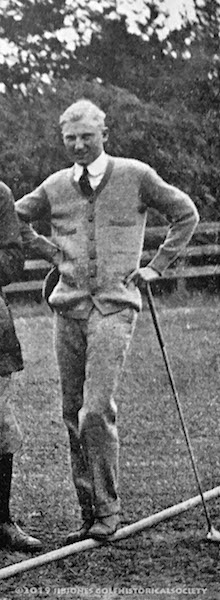
Harold Sampson scored a course record 70, in July, 1918, the same month that alcohol was banned at the Hotel Del Monte, at Pebble Beach, and over the rest of the Monterey Peninsula until the War ended, which was another huge blow to the Del Monte company’s business. In September, Sampson left his shop to take over from Walter Fovargue in San Francisco. He didn’t return until 1919, when the new Del Monte Lodge was opened on Washington’s Birthday.
Jack Neville joined the United States army at Camp Lewis in September 1918, as World War I took over everyone’s lives
To be continued…
© 2019 J.I.B. Jones/GolfHistoricalSociety – All rights reserved.
W. Herbert Fowler at Del Monte No. 2 at Pebble Beach
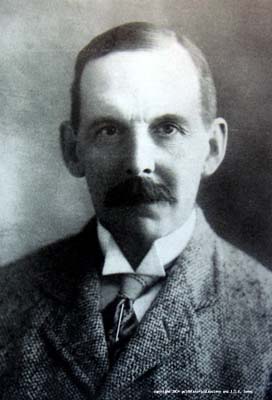
When he arrived in New York from England in 1920, W. Herbert Fowler was already a long time Royal and Ancient amateur golfer, who had won the Jubilee Vase in 1902, and the Bombay Medal in 1903, at St Andrews, and had played on the English golf team of 1903-1905, against Scotland. In his early days he was a crack cricketer, playing for Somerset County. As the dean of the British Experts in golf course architecture, he came to America in January 1920, and headed to California.
Now that the ball-makers have successfully ruined most of our leading courses, it remains for the golf architects to so design the greens that they shall be both difficult of access and that the putting shall demand care and skill in judging slopes and undulations. – W. Herbert Fowler
Mr. Fowler belonged to the following clubs in 1920: Royal and Ancient, Royal North Devon, The Honourable Company of Edinburgh Golfers, Royal St. George’s, Cooden Beach, Burnham, Somerset, and Walton Heath, where he was also manager. Fowler was also a long time director of the Royal and Ancient.
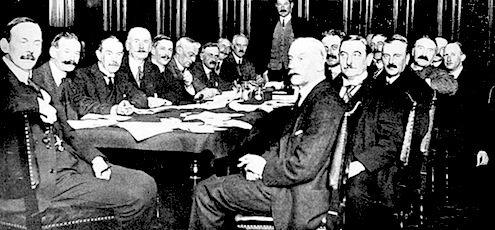
William Herbert Fowler’s home club, and course design masterpiece, was Walton Heath Golf Club, which, when it opened in 1904, was the longest golf course in England, just as the Haskel Ball was changing the game, and making the old golf courses obsolete. The legendary James Braid was Walton Heath’s head professional.
The outstanding features of the seventeenth hole at Walton Heath are more grandiose, their creator – Herbert Fowler – being of Anakim. No doubt he was assisted by recollections of the seventh hole at St. Andrew’s in the good old days before the short cut to it on the right of the hills was opened up. Then it was necessary to pick up a long second with a brassie or cleek, steering the ball home to the left of Strath, and not too much to the left lest it be caught in the sand by the Eden. It is hardly too much to say that the measure of glory which has departed from St. Andrew’s is preserved at Walton Heath. – The Professional Golfers of America, August 1920
Between 1920 and 1923, Herbert Fowler traveled between San Francisco and Los Angeles, remodeling and designing many of the great golf courses of California, including; the Burlingame Country Club, the Presidio of San Francisco, Menlo Country Club, Sacramento Country Club, Lincoln Park Municipal, Olympic Club, Crystal Springs Country Club, Sequoyah Country Club, Victoria Club, Los Angeles Country Club – North and South, Rancho Golf Club, Del Monte No.1, and Del Monte No.2 at Pebble Beach.
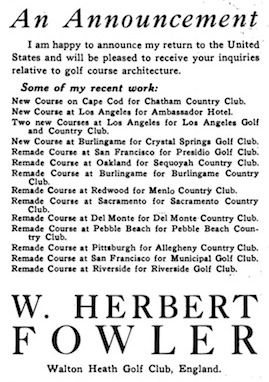
Fowler remodeled the historic, William Robertson designed, Del Monte No.1 golf links, nine holes at a time, starting early in 1920. By April he had also made a plan for lengthening the troubled Del Monte No.2, at Pebble Beach, which was considered too short for the big hitters, with only holes; 2, 6, and 14, up to the challenge. Surprisingly, this was deemed necessary, despite the many alterations made to both courses from 1918 through 1919 by the Del Monte Country Club Green Committee, led by Francis McComas, Douglas Grant and Charles E. Maud. Less than a month before Fowler arrived to remodel Del Monte No. 1 and 2, the Green Committee announced that both golf courses had never been in better shape!
It was Douglas Grant of Burlingame, the son of a wealthy merchant in San Francisco, a Yale graduate, who had married the daughter of Sir William Rutherford, the Mayor of Liverpool, who helped bring W. Herbert Fowler to California. Grant lived in England from 1910 to 1915, mainly for his golf game. His home course was Herbert Fowler’s Walton Heath Golf Club, where James Braid was his teacher. He also played at Royal St. George’s, and at other clubs around London, and in the south of France. He entered many major amateur and Open events during those years, and was well known in the press. In 1912 he beat John Ball in the Irish championship.
Bernard Darwin, who called Fowler “perhaps the most daring and original of all golfing architects”, recalled meeting Grant, the smooth swinging Californian, at Woodcote Park, the sensational new golf course Fowler built for the Royal Automobile Club in 1915.
Douglas Grant is credited with co-designing Del Monte No. 2 at Pebble Beach with Jack Neville. He returned to California from England in January 1916. On his first visit to Del Monte in February, he was said to have said that the land at Pebble Beach was “some of the best he has ever seen for the construction of a course. It is very probable that the Del Monte management will start the construction of a new course at the seaside resort in the very near future.”
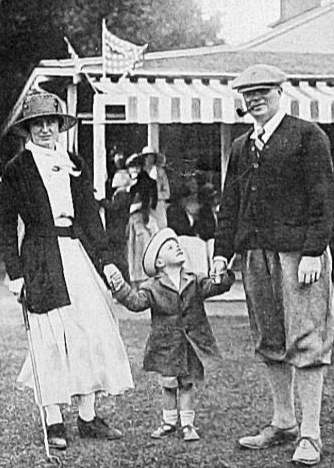
Grant, left San Francisco with his family, and headed back to live at Walton Heath, in October, 1919. One can imagine the conversation Grant and Fowler had back in England, concerning the latter’s upcoming trip to California in the new year, where he would be remodeling Grant’s home courses; the Burlingame Country Club, and Del Monte No.1 and No. 2 at Pebble Beach!
According to Hay Chapman, in the San Francisco Chronicle, W. Herbert Fowler’s 1920-1922 alterations to the Pebble Beach links included:
New back tees added to holes 2,6,9,10,11,13 & 18.
New greens built for holes 1,7,9 & 12.
New traps added to holes 1 & 17.
Hole 5 was also straightened.
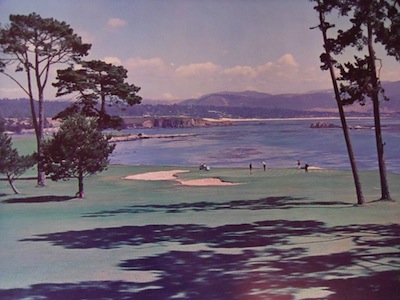
In the summer of 1922, Fowler’s most radical alteration was the building of a new raised green in front of the Lodge. With a raised tee, calling for an accurate shot with the ocean as a hazard, it makes a 535 yard hole. The fairway has been widened and it will be a big improvement over the eighteenth of last year, creating what many say is one of the finest finishing holes in golf.
The final W. Herbert Fowler updates at Pebble Beach were completed for the 1923 Del Monte summer season:
New tee at 2, lengthening the hole from a par 4 to a par 5
New tee and green at 3.
New larger tee at 4.
New tees at 5 and 6, ten yards added.
New tee at 10, moved to the right to tempt the long hitters
New tee at 13.
New tee and green at 14, lengthening it from a par 4 (430) to a par 5 (580), the longest hole in the state
New larger tee at 15.
New green at 16, hogback removed.
W. Herbert Fowler at Del Monte No.2, Pebble Beach by J.I.B. Jones
All rights reserved. ©Copyright 2010-2017 golfhistoricalsociety and J.I.B. Jones
